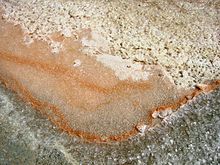Fleur de sel

Fleur de sel ("flower of salt" in French; French pronunciation: [flœʁ də sɛl]), flor de sal (in Portuguese), or flor de sal (in Spanish and Catalan) is a hand-harvested sea salt collected by workers who scrape only the top layer of salt before it sinks to the bottom of large salt pans.[1] Traditional French fleur de sel is collected off the coast of Brittany, most notably in the town of Guérande (called Fleur de Sel de Guérande), but also in Noirmoutier, Île de Ré[2] and Camargue.
Flor de sal also has a large production in Portugal,[3] mostly in the Aveiro District and in the Algarve, being commercialized worldwide from the ancient salt production regions existing in this country, by traditional methods, with high certified quality standards. It is an artisanal food product. Due to its relative scarcity and its labor-intensive production, flor de sal (flower of salt/fleur de sel) is one of the most expensive salts.

Spain also produces some high quality flor de sal in the Salinas d'Es Trenc on Mallorca island,[4] and in the Salinas de la Trinidad in the Ebro Delta.[5] Both salts are exported worldwide.
Since ancient times, salt has also been harvested off the rocks of southern Greece. The ancient Greeks referred to the salt as "anthos alatiou" which translates into fleur de sel. Even today, in remote parts of Greece salt is still harvested off the rocks as it was many centuries ago.
Canada now produces high quality fleur de sel from the Pacific Ocean off Vancouver Island.[6]
Brazil has also started producing some flor de sal in the traditional salt-producing area of Mossoró, in the state of Rio Grande do Norte, and iodized, as mandated by Brazilian law for all salt intended for direct human consumption.[7]
A major source of "Flor de sal" since Aztec times, is on the Pacific Coast of Mexico, where it is harvested by hand in the Lagoon of Cuyutlán, then processed and shipped from the village of Cuyutlán throughout the world. There is a museum here also, dedicated to the history and technique of "Flor de sal" production. /ref Museo de Sal, Cuyutlán, Armeria, Colima, Mexico.
Flor de sal is also being harvested along the beaches of Celestun in Yucatan, Mexico where Mayans cultivated salt 1,500 years ago for its distribution throughout Mesoamerican trade routes extending to Guatemala, Central America and the Caribbean.[8]
Fleur de sel is often slightly grey due to the sand collected in the process of harvesting the salt from the pans. On occasion, the presence of Dunaliella salina (a type of pink microalga commonly found in salt marshes) can give it a light pink tint. It is usually sold in sealed jars.
Fleur de sel has more mineral complexity than common table salt. Fleurs de sel are moist salts. Portuguese brand Flos Salis, for instance, contains from 5.4 to 8.1% residual moisture,[9] while others can reach upwards of 10%.[10] The following is a chemical analysis of Flos Salis:[11]
| Mineral | Quantity |
|---|---|
| Sodium chloride | 94.3 - 97.6% |
| Calcium | 0.19 - 0.20% |
| Magnesium | 0.42 - 0.79% |
| Potassium | 0.22 - 0.67% |
| Iron | 8.0 - 11.1 mg/kg |
| Iodine | 0.5 - <3 mg/kg |
See also
References
- ^ http://www.davidlebovitz.com/2006/09/fleur-de-sel-de-1/ | David Lebovitz on fleur de sel
- ^ http://www.sel-de-re.tm.fr/index.php?option=com_content&view=category&layout=blog&id=29&Itemid=40&lang=en
- ^ http://www.flordesal.net/history.htm
- ^ http://flordesaldestrenc.com/
- ^ http://www.flordeldelta.com/
- ^ http://www.visaltco.com
- ^ Orenstein, José (14 Nov 2012). "É sol, é sal, é flor de sal". O Estado de S. Paulo ("Estadão") (in Portuguese). Retrieved 2012-11-15.
- ^ Medellin, Carolina. "Spice of Life: Celestun's Superb, Sustainable Salts" (PDF). Catherwood Travels. Retrieved 13 August 2013.
- ^ http://www.flor-de-sal.com/chemical-composition.html
- ^ Bitterman, Mark (2010). Salted: A Manifesto on the World's Most Essential Mineral, With Recipes. Ten Speed Press. p. 75. ISBN 978-1-58008-262-4.
- ^ http://www.flor-de-sal.com/chemical-composition.html
